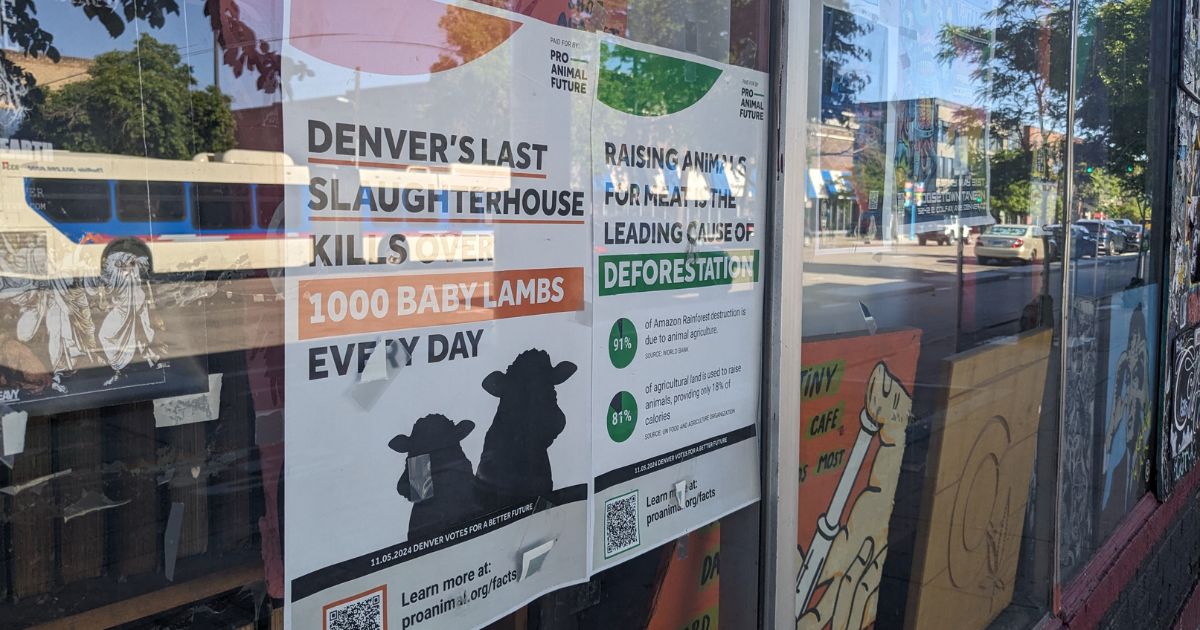News
Sentient Impact Report 2025
Policy•1 min read
Solutions
Activists got a slaughterhouse moratorium on Denver’s ballot — but what are its chances?


Words by Grace Hussain
The largest lamb slaughterhouse in the country is located in the Globeville neighborhood of Denver, Colorado. Each year, up to 500,000 young sheep are carted into the facility, and leave as packaged meat. Now, Denver is poised to be the first city in the nation to ban slaughterhouses like this one. Thanks to a campaign spearheaded by Pro Animal Future — a nonprofit organization with tactics backed by research — voters will decide this November whether to allow the facility to continue operations.
Its success or failure could have broad implications for the animal rights movement. While it’s certainly not the first time that animal advocates have sought to leverage ballot initiatives — there’s currently also an initiative to ban factory farms from Sonoma County, California — the Denver campaign could serve as a blueprint for future campaigns in cities across the country.
Pro Animal Future was started to test out the research generated by their sister organization, Pax Fauna. That research suggested that animal rights activists could garner success by shifting the framing of their work to ask for people’s votes instead of personal dietary change — a finding that led to this and another ballot initiative in Denver.
“We had a lot of people sign these petitions, including the slaughterhouse petition, while eating animals,” Aidan Kankyoku, who worked on the research and is now spearheading the campaign, tells Sentient.
Though the fate of the slaughterhouse still hangs in the balance, even getting the question on the ballot was an uphill climb. Kankyoku embarked on it in hopes of testing the findings of Pax Fauna’s research. So far, those findings are holding up, which may have far-reaching implications for animal welfare groups.
In 2023, Pax Fauna published research which found that calling meat out as unsustainable or cruel is not very effective for the average consumer, in part because it ignores the large role of corporations and policymakers, and relies too heavily on changing personal choice. Instead, focusing on collective action and civic duty — via voting, for example — appears to be more effective.
Those findings were based upon a series of focus groups, surveys and interviews with over 200 participants, all of whom eat meat. After writing up and publishing their findings, their next steps were clear: the new grassroots framework they had designed needed to be tested. For that testing, they chose Denver.
“This is where we have the most progressive and liberal voters who are going to take the first step and set this precedent to say ‘no’ to slaughterhouses,” says Kankyoku. In November of last year, the team dropped off 10,488 signatures supporting a ballot initiative to ban slaughterhouses from the city — well above the 8,940 needed to get on the ballot. Pro Animal Future ran a fur ban initiative alongside the slaughterhouse ban, which received 11,708 signatures, and will also be appearing on ballots in November. Each of those signatures represents a conversation with a campaigner.
One of those campaigners is volunteer Alaina Sigler, who runs the nonprofit The Night Sky Garden. “These very meaningful conversations are going to be one of the most important tactics for us to continue to focus on,” Sigler says, referencing the deep canvassing technique at the center of the campaign. Deep canvassing relies on having sincere conversations with voters, and offers space for people to express their concerns without judgment. Though the tactic is great for helping people understand an issue, it is time intensive. “It’ll be anywhere from three to 12 voters in an hour, if you’re walking up to groups,” says Kankyoku.
In addition to these conversations, volunteers have been hosting postcard writing parties in collaboration with other local organizations, including nearby Luvin Arms Animal Sanctuary. While most of those writing parties are dominated by people already involved with the campaign, Pro-Animal Future works hard to ensure a welcoming environment for everyone — whether they eat meat or not.
“If you have friends, family members…and they’re not vegan, we actively are asking folks to bring them to the social events,” Sigler, who has organized several such parties, says.
From Sigler’s perspective, the campaign is cause for “immense hope for these initiatives, after not seeing much change occur locally for animals.” A longtime grassroots activist, Sigler has years of experience as an organizer for Direct Action Everywhere, standing vigil outside slaughterhouses and canvassing.
She and other volunteers have also been active in another facet of the campaign: flyering the city. “We do have this kind of guerrilla marketing component of the campaign as well,” says Kankyoku. In addition to the flyers, volunteers hand out stickers, chalk art and messages around the city, and are working with businesses to host events.

In addition to being home to the nation’s largest lamb slaughterhouse, Colorado also plays host to Colorado State University (CSU). CSU is home to AgNext, (an agricultural research institute that has come under fire for its connections to animal agriculture), as well as Regional Economic Development Institute (REDI), a research center focused on economic development.
In April of this year, REDI released a policy brief arguing that eliminating the slaughterhouse could result in a maximum loss of 629 jobs and over $861 million. Kanyuko says he doesn’t believe those numbers are feasible, given that the facility has 160 employees and generates roughly $250 million in revenue annually. “It’s just obvious propaganda, if you’re going to dig into it a little bit,” he says, but “they’re using the letterhead of this respected university.”
The processes put into the report are standard within economics, says Dawn Thilmany, PhD, who led the team that put together the REDI brief. Analysis was based upon government data run through an economics software program that calculates likely ripple effects.
The analysis outlines three possible scenarios, based upon how much of the lamb industry exits the state of Colorado. Should the initiative pass, Thilmany is concerned that the most drastic of those scenarios is the most likely to take place. “It’s [likely to be] really hard to get investors to build processing capacity in other parts of [Colorado] because they’re afraid the ban is going to get wider than Denver County,” she says.
From her perspective working with small producers, the Denver slaughterhouse is unique in that it allows producers to get back their animals following slaughter — a rarity within the industry. For producers who sell meat locally, getting their animals back is essential. “Anyone who’s selling local[ly], that’s what they have to do,” she says. “For lamb, I think they’re about the only one who can do that, even in the region.”
Even if the report’s worst-case economic scenario does come to pass, points out Kankyoku, the projected impact of shutting down the slaughterhouse represents only a small fraction of the state’s overall economy. In the third quarter of 2023, Colorado’s real Gross Domestic Product — a measure of economic activity — was $529.1 billion.
“What’s so exciting about the ballot initiative approach is that we’d much rather be talking to voters than to a few city council members,” says Kankyoku. Focusing on voters also means that even a loss is a win, in Kankyoku’s eyes. “If we focus all our attention on engaging with the public and connecting with local businesses and building a really strong community around this objective, [even] if the measure doesn’t pass, we can still feel very confident that all of that work is setting us up to do better next time, whether it’s the same policy or a different policy for the next campaign.”
Pro Animal Future’s partner organization, Pax Fauna, is already gearing up to launch similar campaigns in cities across the country — starting with Portland.
Even with the growing popularity of ballot initiatives as a means of activism, advocates are restricted to the cities and states that allow them. But with roughly three quarters of cities allowing some form of citizen-supported legislation making, the opportunities for animal advocates are numerous.
This story is part of a series called How Food Justice is Made: Stories and Solutions, in which Sentient dives into four different communities, and the unique ways they’re combatting slaughterhouses.